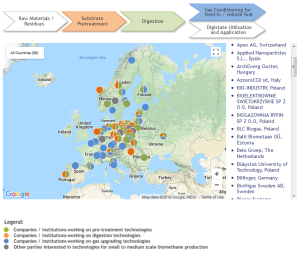Biomethane Map is an interactive platform which is implemented within the Horizon 2020 Record Biomap project to build up a network for all stakeholders who work with technology solutions for substrate pre-treatment, digestion processes and biogas upgrading.
So far, biomethane production has been economically viable only at large scale, however, worldwide most of the agriculture takes place at smaller scale: it is therefore necessary to support the development of technology solutions for small to medium scale biomethane production. For this reason, numerous European stakeholders from science and industry sectors are working on different technology solutions to make small or medium scale biomethane production available in the future, e.g. for smaller farms.
The Biomethane Map has been developed in the framework of the EU-funded Horizon 2020 project “Record Biomap”. The map presents about 80 SMEs (small and medium-sized enterprises), industry players and research institutions around Europe, who investigate on the above-mentioned technologies to reach a cost-effective and energy-efficient biomethane production by means of plants with a production capacity of below 200 Nm³/h raw biogas.
Alongside with company profile, the Biomethane Map hosts information about the technologies along the whole biomethane supply chain, from substrate pre-treatment, digestion systems up to gas upgrading processes, wherever there is potential to save production energy or gain other advantages, compared to large-scale plants.

The listed technologies are yet in the first phases of their development, e.g. between experimental proof of concept and a validated prototype (Technology Readiness Level 3-5 according to EC definition). That is why it is important to bridge the gap between research and market to support the further development of these technologies. If small-scale biomethane production would become economically viable, farms with small biogas plants could considerably contribute to the production of fossil-free energy or vehicle fuel in decentralized areas. Biomethane may represent a key element to energy self-sufficiency in rural areas and an essential contribution to renewable energies. The map is interactive and can be filtered according to the different steps of the biomethane supply chain, from substrate pre-treatment and anaerobic digestion to the last phase where biogas is upgraded to biomethane. There are different small-scale upgrading technologies that are currently under development, such as the wood ash filter, which is suitable for small scale farm digesters with regional availability of wood ash (e.g. in Northern European countries such as Sweden, Norway and Finland). Another technology works thanks to an algal bacterial system, where CO2 and H2S are removed within a single upgrading step with relatively low energy input: it is environmentally friendly and economically viable, however, it can only be applied in warmer regions, such as South European countries.
The assessment also includes results about the performance of pre-treatment and anaerobic digestion technologies. The pre-treatment of substrates has a great influence on the digestion process as it enables the use of biomass by considerably increasing the biodegradability of typical organic substrates used for biogas production. The Biomethane Map presents a number of different pre-treatment technologies with different technical solutions, characteristics, advantages and disadvantages, depending on which substrates are available. To name a few examples, technology descriptions (TD) are available for different ultrasound disintegrators which are able to largely increase the amount of biogas without adding any chemicals; the change pressure disintegrator or the hydrodynamic disintegrator which both can be applied especially for substrates of poor quality; fine chopping of cellulolytic raw materials such as fibrous materials; pressure swing conditioning or the combined hydrolysis with wave box.
Another equally important phase of the biogas production is the digestion process. The efficiency of this complex biochemical process can be influenced by several factors, such as the fermenter temperature, the retention time, the organic loading rate and among others the mixing method, e.g. continuously stirred reactor, plug flow reactor, a box or garage type reactor, etc. The Biomethane Map presents around 20 different digestion technologies under development, which can be applied to micro, small and medium biogas plants. These and other promising technology solutions (e.g. upgrading technologies like special membrane technologies, membrane contactors, biological methanation, vacuum pressure swing adsorption, etc.), for small scale biogas plants, have been assessed according to hard facts like energy demand, capacity, methane content, methane slip, GHG-emissions and economics etc. as well as regarding their advantages or disadvantages, e.g. their special application area etc. The results of this assessment will be published by end of 2018.
Additionally, the project identified and described present biogas and biomethane development conditions within different European countries to set the basis for technology relevant market implementation strategies. An overview on the administrative and legal conditions as well as on financial and other support programs for small to medium scale biomethane production and supply across Europe can be found in this report.
For futher information, visit project website; e-mail contact: info@biomethane-map.eu
![]() This project has received funding from the European Union’s Horizon 2020 research and innovation programme under grant agreement No 691911.
This project has received funding from the European Union’s Horizon 2020 research and innovation programme under grant agreement No 691911.
Text provided by Virginie Bellmann, Kathrin Bienert; DBFZ Deutsches Biomasseforschungszentrum gemeinnützige GmbH.


